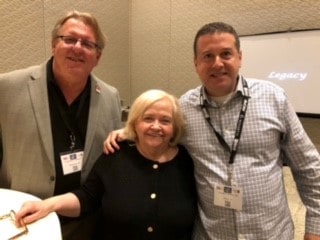Introducing “Pick 3 With The NHF”, an interview series where we will be asking three questions of patient advocates, healthcare providers, supporters, and people living with migraine disease and headache disorders.
Mary Franklin was the Executive Director of the National Headache Foundation from June 2016 until retiring in November 2020. She joined the Foundation staff in September 2011 as Director of Operations. In September 2011, she retired from the Diamond Headache Clinic, Chicago, as Vice President of Publishing and Administration, where she had previously held various positions in the nursing and administrative departments. She joined the staff of the Diamond Headache Clinic in 1970.
She was the Managing Editor of the magazine, Head Wise. Previously, she served as Managing Editor of the professional journals, Headache Quarterly, and Headache and Pain – Current Treatment and Research. She has authored several articles on headache disorders, and with Seymour Diamond, M.D. is the coauthor of Conquering Your Migraine (2001) and Headache Through the Ages (2005).
A native Chicagoan, she received an M.A. in Chicago Studies from Loyola University Chicago, where she had studied nursing. She also received a B.Ph. in History from Northwestern University.
1. How did you get involved in headache medicine?

Dr. Fred Freitag, Ms. Mary Franklin, and Dr. George Nissan
Through the back door. I was hired as a staff nurse at a family care practice (Diamond-Baltes Medical Associates) and they just happened to also have a headache section of their practice. That was in September 1970. By 1972, the practice was limited to headache disorders. In that year, I became the head nurse in the biofeedback department — the first private clinic to use biofeedback as a treatment modality.
2. How has the perception of migraine disease and headache disorders changed since you started working in the field?
There was no concept of headache medicine in those years. Doctor Seymour Diamond was laughed at and ridiculed for focusing on headache disorders. Headache specialties were limited to academic institutions. Through his efforts with both the National Headache Foundation and the American Association for the Study of Headache (now AHS), public awareness grew. With each new treatment available for migraine disease, publicity grew. I would say the three major events in the last 50 years in headache medicine were the approval of propranolol for migraine prophylaxis (1976), the introduction of the triptans in acute migraine management (the early 1990s), and finally the introduction of the CGRPs in 2018.
3. Are you or any family members living with migraine disease?
I had been working at the Diamond Headache Clinic for about 20 years, when my aunt finally admitted that she had migraine disease as a young woman, and continued to experience visual auras. This was after my 10-year-old son started experiencing migraine attacks. My aunt also admitted that my mother had menstrual migraine and my grandmother also suffered from migraine disease. Luckily, my son’s headaches eventually resolved after high school. I didn’t experience a migraine until my son was born, My migraine attacks are very infrequent and easily treated with over-the-counter medications.
